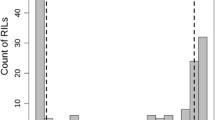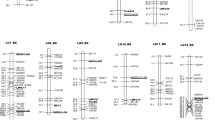Abstract
Genetic maps facilitate the study of genome structure and evolution, and the identification of monogenic traits or Mendelian components of quantitative traits. We evaluated 228 RAPD, microsatellite and AFLP markers for linkage analysis in melon (Cucumis melo L.) varieties MR-1 (resistant to Fusarium wilt, powdery and downy mildews) and Ananas Yokneum (AY; susceptible to these diseases) and constructed a detailed genetic map. The mapping population consisted of 66 backcross progenies derived from AY×(MR-1×AY). Despite a relatively low level of polymorphism in the species, AFLP markers were found to be more efficient in mapping the melon genome than RAPD or microsatellite markers. The map contains 197 AFLPs, six RAPDs and one microsatellite marker assigned to 14 major and six minor linkage groups, and covers 1942 cM with the average distance between adjacent markers of approximately 10 cM. The maximum distance allowed between markers is 27.5 cM. About 11% of the intervals (20 out of 173) are over 20 cM (but less than 27.5 cM). The map has immediate utility for identifying markers linked to disease resistance genes that are suitable for marker-assisted breeding. The use of microsatellite markers for integration with other maps is also discussed.
Similar content being viewed by others
Author information
Authors and Affiliations
Additional information
Received: 12 March 1997 / Accepted: 20 May 1997
Rights and permissions
About this article
Cite this article
Wang, YH., Thomas, C. & Dean, R. A genetic map of melon (Cucumis melo L.) based on amplified fragment length polymorphism (AFLP) markers. Theor Appl Genet 95, 791–798 (1997). https://doi.org/10.1007/s001220050627
Issue Date:
DOI: https://doi.org/10.1007/s001220050627




